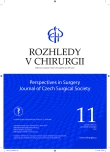Branched pedal bypass in the treatment of critical limb ischemia – a single center experience
Authors:
T. Grus 1; P. Mitáš 1; P. Lukáč 1; J. Hrubý 1; J. Lindner 1; G. Grusová 2; L. Lambert 3
Authors‘ workplace:
II. chirurgická klinika kardiovaskulární chirurgie Všeobecné fakultní nemocnice a 1. lékařské fakulty Univerzity Karlovy, Praha
1; IV. interní klinika – klinika gastroenterologie a hepatologie Všeobecné fakultní nemocnice a 1. lékařské fakulty Univerzity Karlovy, Praha
2; Radiodiagnostická klinika Všeobecné fakultní nemocnice a 1. lékařské fakulty Univerzity Karlovy, Praha
3
Published in:
Rozhl. Chir., 2018, roč. 97, č. 11, s. 509-513.
Category:
Original articles
Overview
Introduction:
Pedal bypass is a therapeutic option for limb salvage in critical limb ischemia.
Method:
Retrospective analysis of 20 patients who underwent either simple (14 patients) or branched (6 patients) pedal bypass in a single center and had at least one postoperative follow-up. In patients with branched pedal bypass, the main trunk was connected to the pedal artery of better quality and the side branch to an artery on the opposite side of the foot. The main trunk was constructed as a reverse saphenous bypass in all patients with branched bypass. From patients with simple bypass, nine had reverse saphenous graft, three had an allograft, one patient had in situ saphenous graft, and one PTFE prosthesis.
Results:
The difference in the operation time was not significant. One patient with simple bypass required reoperation for wound bleeding and there was one case of perioperative mortality in the same group. The difference between the groups in the primary or secondary patency rates, limb salvage and overall survival was not significant.
Conclusions:
We did not find any significant difference in patency rates, limb salvage, or perioperative complications between patients with simple and branched pedal bypass in our cohort. We believe that the anticipated benefits of constructing an additional branch are masked by the disadvantageous presence of an additional anastomosis. Adoption of a branched pedal bypass may therefore require further improvements – perhaps the utilization of a branched saphenous graft.
Key words:
critical limb ischemia – peripheral arterial disease – bypass – revascularization – amputation
Sources
1. Narayan KMV, Boyle JP, Geiss LS, et al. Impact of recent increase in incidence on future diabetes burden: U.S., 2005–2050. Diabetes Care 2006;29:2114–6.
2. Apelqvist J, Bakker K, van Houtum WH, et al. International consensus and practical guidelines on the management and the prevention of the diabetic foot. International Working Group on the Diabetic Foot. Diabetes Metab Res Rev 2000;1:S84−92.
3. Staffa R, Leypold J, Kríz Z. Pedal bypass for limb salvage. Acta Chir Belg 2005;105:491–6.
4. Hofmann WJ, Magometschnigg H. Pedal artery bypass. Acta Chir Belg 2004;104:654–8.
5. Staffa R, Kríz Z, Gregor Z, et al. Pedal bypass grafting on arteriographically invisible foot arteries detected by duplex ultrasound for limb salvage. Minerva Chir 2007;62:115–24.
6. Grus T, Lindner J, Vidim T, et al. The anastomosis angle is a key to improved long-term patency of proximal femoropopliteal bypass. Ann Vasc Surg 2009;23:598–605.
7. Yoshida R de A, Silva CEC da, Sobreira ML, et al. Infrapopliteal angioplasty: the more arteries are treated the better? J Vasc Bras 2008;7:176–82.
8. Pomposelli FB, Kansal N, Hamdan AD, et al. A decade of experience with dorsalis pedis artery bypass: analysis of outcome in more than 1000 cases. J Vasc Surg 2003;37:307–15.
9. Brochado Neto FC, Cury MVM, Costa VS, et al. Inframalleolar bypass grafts for limb salvage. Eur J Vasc Endovasc Surg 201040:747–53.
10. Slim H, Tiwari A, Ritter JC, Rashid H. Outcome of infra-inguinal bypass grafts using vein conduit with less than 3 millimeters diameter in critical leg ischemia. J Vasc Surg 2011;53:421–5.
11. Grus T, Lambert L, Grusova G, et al. Branched crural bypass has no advantage over simple crural bypass in the treatment of peripheral arterial disease. Int J Clin Exp Med 2017;10:7859–66.
Labels
Surgery Orthopaedics Trauma surgeryArticle was published in
Perspectives in Surgery

2018 Issue 11
Most read in this issue
- Dunbar syndrome – single-center experience with surgical treatment
- Hypogastric artery aneurysm – a case report
- Trauma of the extracranial cerebral arteries due to injuries of the cervical spine
- Indications to open surgical revascularization of visceral arteries in the endovascular era
